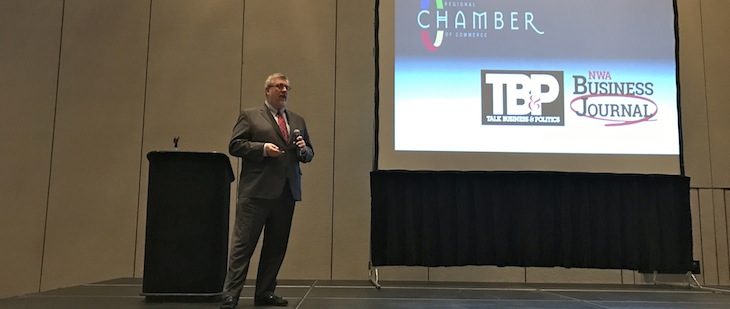Strategist: Fort Smith economy still ‘at risk,’ new approach to job training needed
by May 6, 2017 12:24 pm 1,061 views

Ted Abernathy, an economic development strategist and managing partner of Economic Leadership LLC, gave the keynote address at the Fort Smith Regional Chamber of Commerce First Friday Breakfast on May 5.
Fort Smith’s economy is underperforming when compared to state and national levels, and its manufacturing-heavy job sector is putting it at further risk.
Those were two of the many takeaways from Ted Abernathy, an economic development strategist and managing partner of Economic Leadership LLC, who gave the keynote at the Fort Smith Regional Chamber of Commerce First Friday Breakfast on May 5.
Speaking to a gathering of political and business leaders, Abernathy gave the city an in-depth analysis of its economic conditions, stating that despite the fact unemployment had slipped to 4.5%, the city continues to run behind on construction jobs (just under 4%) while being leveraged too high in manufacturing at 16.9%.
“That’s high. Given the manufacturing nature of the world, that puts you at risk,” Abernathy said. “We’re in the eighth year of a business cycle, and there’s a reason they call them cycles. There will be a downturn sometime, and that will hurt you worse than it will your neighbors that are not as manufacturing heavy.”
Additionally, the low unemployment rate runs parallel to a “slipping” labor participation rate. “You don’t have quite as many people in the labor force as in the year before. Concentrating on that labor force will be key for you moving forward.” Still, Abernathy noted, the job mix in Fort Smith is “pretty healthy” for a city in transition that is “not transitioning as fast as the state economy.”
When understanding how to move forward, Abernathy said, it’s important to understand the factors that influence local economies. The rapid rate of change in technology and other factors as well as “global issues” have an impact.
“The high global rate of unemployment causes downward pressure on our wages. If we don’t do anything else, there are about a billion people in the world, who want a job but don’t have a job. That makes supply and demand curves worse.”
Abernathy continued: “GDP is still growing at about half what we thought it would be worldwide. Our strong dollar makes it a little harder to sell. That means it’s a great year if you want to go to Greece and run around the islands because your dollar goes a long way. But it’s a bad year if you want to sell somebody something.”
Abernathy also advised keeping an eye on foreign relations with trade negotiations in flux between the U.S. and its two biggest trade partners (Canada and Mexico) in the age of Trump.
“What’s our relationship going to be? Our next big group of trading partners is the EU. What’s Brexit going to do? As we go to Asia, how are those relationships going to be? President Trump has signaled that he’s going to try and change some of those. What will happen? How will the negotiations go? We’ve been in a stable world for a while on trade, and most people do not predict that going forward,” Abernathy said.
‘SKILLED LABOR IS AT THE TOP’
One issue that hits particularly close to home is the fact that a greater segment of the workforce (millennials) are “urbanizing.”
“Fifty-seven percent of people live in metropolitan areas of one million or more,” Abernathy said. “In other words, more and more people are living in fewer and fewer places. And a lot of that is because millennials and GenYs choose to live in denser, bigger places.”
To illustrate this point further, Abernathy noted that over half the country lives in 144 counties with the rest living “in the 3,000-plus remaining counties.”
Ultimately, cities that want to attract businesses need to remember: “For people, who are looking to site businesses today, availability of skilled labor is at the top. Everywhere we (at Economic Leadership) go in the country and world, we hear, ‘How can we get the labor?’ It is the first thing everyone asks. Approximately 93% say workforce is the most important thing, Abernathy said.
“If you don’t have the workforce, you will never get past the part in the process where a company looks at you from afar and decides whether to assess you,” he said.
ECONOMIC OUTLOOK, WITH A BULLET
Following are some other key points Abernathy shared.
• Robots are coming for about one-third of existing jobs in the next 10 years.
• The workforce is either “terribly undersupplied” in some areas while slightly “oversupplied” in others. It is the “middle skills” that are really lacking. “Most jobs (needed) are in the middle.”
• Only 23% of jobs will require either a bachelor’s, master’s, or doctorate degree in the years ahead.
• 91% of employers will not hire someone with the appearance of poor personal hygiene and 74% won’t hire someone with facial piercings.
• If you are a 40-year-old employee, you will have to be retrained. If you’re a 20-year-old, you’ll have to be retrained several times throughout your career.”
